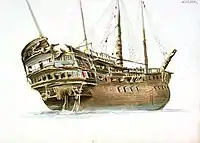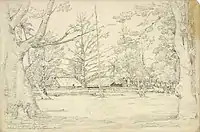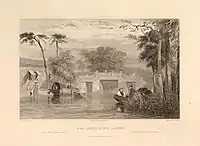Robert Elliot (Royal Navy officer)
Robert James Elliott (born 12 May 1790 Wheldrake, Yorkshire – died Pentonville, London 30 April 1849)[1] (fl. 1822–1833), was an English naval officer, Captain in the Royal Navy, and known as a topographical draughtsman from 1822 to 1824.

Elliot (Elliott) was the son of the Reverend Robert Elliot and Mary. His father was a younger brother of Gilbert Elliot-Murray-Kynynmound, 1st Earl of Minto, the Governor-General of India between 1807 and 1813.[2] His cousin, Minto's son, George served during the same period.[3]
He entered the Royal Navy as a Cadet in 1802, and served his country with honour during the Napoleonic War. His name appeared in the London Gazette in 1807, and he was made a lieutenant for his gallantry in charge of the boats of the Fox, in 1808 when he was severely wounded in trying to cut out a ship from Batavia Roads.[4][5]
Promoted to Lieutenant in 1808, and from then to 1814 he served in the East Indies. He was made Commander on 27 August 1814.[6] From 1822 to 1824 he was in command of a vessel that toured India, Canton, and the Red Sea during this period he made numerous on the spot sketches.
When in London on retirement, he busied himself with charity work for benefiting sailors, and support for a sailors’ home.[7] The Sailors' Home, Well-street, was originally founded in 1828 by Captain R. J. Elliot, R.N., Admiral G. C. Gambier, and Lieut. R. Justice, R.N., who, in the previous year, had successfully started the Destitute Sailors' Asylum; the destruction of the Brunswick Theatre in Well-street affording the opportunity for carrying out the scheme. Up to that time nothing had been done for the protection of seamen.[8]
In 1846 he was awarded the commander's out pension of Greenwich Hospital. He died at Pentonville on 30 April 1849.[9]
Some of the sketches he had made on his travels were published under the title View in the East in 1833. In that edition, the letterpress descriptions were drawn from a variety of published works, including Amelia Heber’s posthumous edition of Reginald Heber’s Narrative of a Journey through the Upper Provinces of India (1828). In the 1835 edition, the publishers Fisher & Co. commissioned Emma Roberts to write new letterpress.
These sketches were worked up by Samuel Prout, Clarkson Stanfield, and others into finished drawings and consequently engraved; they were published in parts by Fisher & Co., appearing 1830–1833, under the title, Views in the East, comprising India, Canton, and the Red Sea, with Historical and Descriptive Letterpress by Emma Roberts.[10]
Views in India, China, and on the Shores of the Red Sea was published in 1835.
Gallery
 A sketch by Elliot of a ruined Mosque in Delhi on the banks of Jumna
A sketch by Elliot of a ruined Mosque in Delhi on the banks of Jumna.jpg.webp) The same sketch engraved by W. Taylor from a drawing by William Purser
The same sketch engraved by W. Taylor from a drawing by William Purser An Elliot sketch of Mandu, the Water Palace
An Elliot sketch of Mandu, the Water Palace.jpg.webp) An engraving made from a similar sketch by W. Floyd, using a drawing by Anthony Fielding
An engraving made from a similar sketch by W. Floyd, using a drawing by Anthony Fielding Starboard quarter of a derelict three-decker
Starboard quarter of a derelict three-decker View west of Bastia May 1813
View west of Bastia May 1813 Queen Pomaree's residence at Oparrea, Tahiti, 1822
Queen Pomaree's residence at Oparrea, Tahiti, 1822 Bridge in Canton
Bridge in Canton
External links
 Media related to Robert James Elliot (Royal Navy) at Wikimedia Commons
Media related to Robert James Elliot (Royal Navy) at Wikimedia Commons
References
- Peach, Annette. "Robert James Elliott - British Travel Writing". University of Wolverhampton. Retrieved 30 September 2020.
- Peach, Annette. "Elliot, Robert James". Oxford Dictionary of National Biography. Oxford University Press. Retrieved 4 October 2020.
- "HMS Modeste". National Maritime Museum. November 1814. Retrieved 5 October 2020.
Elliot painted HMS Modeste - going free...Nov 1814; his cousins ship
- "Naval Intelligence". Edinburgh, Scotland: The Caledonian Mercury. 24 September 1846. p. 4. Retrieved 5 October 2020.
Commander Robert James Elliot (1814)
- Haultain, Charles; Allen (of Greenwich Hospital), Joseph (1842). The New Navy List. Simpkin, Marshall and Co. p. 157. Retrieved 5 October 2020.
54 R. J. Elliot, commanded the boats of the Fox, in a gallant but unsuccessful attempt to cut out a ship from Batavia Roads in 1808, in which he was severely wounded
- Marshall, John (1823). Royal Naval Biography. Retrieved 6 October 2020.
Robert James Elliot, Esq. [Commander.] Was made a lieutenant in Aug. 1808; and commander on the 27th Aug. 1814.
- "Robert James Elliot, died 1849". St George-in-the-East Church. Archived from the original on 25 February 2020. Retrieved 4 October 2020.
Charles Besley Gribble, the first minister of St Paul Dock Street and chaplain to the institutions, wrote The Naval Officer: a new creature in Christ Jesus, exemplified in the living and dying of Captain Robert James Elliot, R.N. (Nisbet 1849).
- Dickens Jr., Charles (1881). Dickens's Dictionary of the Thames. Retrieved 6 October 2020.
The new establishment, when finally completed in 1835,
- "Sailors' Home, Well-street, London Docks (now Ensign Street)". London: The Standard. 7 September 1850. p. 1. Retrieved 6 October 2020.
Sailors' Home, Well-street, London Docks. A marble bust of the late Captain Robert James Elliot, R.N., has recently been placed by his friend, in the dining hall of this institution, and a handsome tablet to his memory has also been erected in St. Paul's, the seamen's church, in Dock-street. Deeplv imbued with a sense Of the evils which bset the social condition of the seaman during his sojourning on shore, more fearful than the direst perils of the great deep, he devoted his time, bis energies, and bis substance to their removal. The Sailors' Home and the Destitute Sailors' Asylum were founded through his exertions, and remain the memorial, of his unremitting and anxious care. The last labour of Icve in Which declining health permitted h m to share was the erection of this church to the hononr and glory of God for the seaman', special use.
- Cust, Lionel Henry. "Dictionary of National Biography, 1885-1900, Volume 17". Wikisource. Arnold's Library of the Fine Arts, i. 152; Nagler's Künstler-Lexikon; Universal Catalogue of Books on Art. Retrieved 30 September 2020.
![]() This article incorporates text from a publication now in the public domain: "Elliot, Robert". Dictionary of National Biography. London: Smith, Elder & Co. 1885–1900.
This article incorporates text from a publication now in the public domain: "Elliot, Robert". Dictionary of National Biography. London: Smith, Elder & Co. 1885–1900.